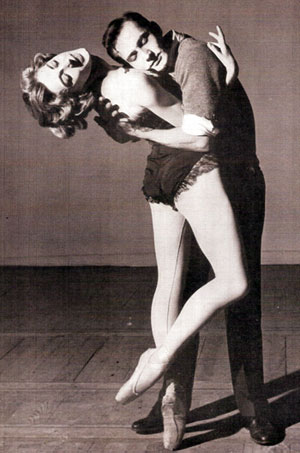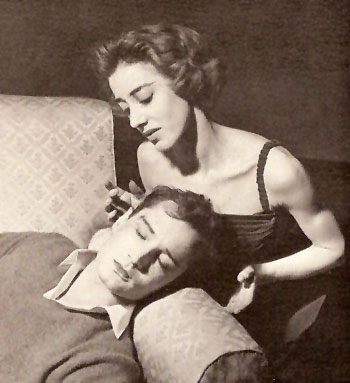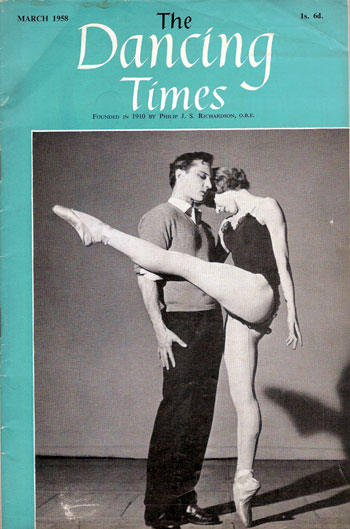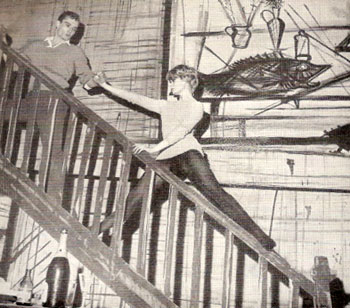| Testimonies
& Critics
Le Rendez-vous manqué (The broken date)
 |
 |
Wladimir Skouratoff and Toni Lander
|
On January 3rd. 1958, the curtain was risen at the Casino Theatre in Monte-Carlo, over the world première of a ballet in three acts, “Le rendez-vous manqué”, music by Michel Magne, choreography by John Taras for acts 1st. and 3rd. and by Don Lurio for the second one. The main dancers were Wladimir Skouratoff, Toni Lander and Noëlle Adam.
The fact that the young French writer Françoise Sagan was responsible for the scenario, issued a great interest both for the public and the specialized critics.
The British critic Peter Williams (Dance and Dancers, March 1958), wrote an extensive review over “the story of the creation of Françoise Sagan’s Le rendez-vous manqué in Monte-Carlo”, from which we quote:
(...) “I had first heard about the Sagan ballet when I was in Seville during the late summer. Albert Sarfati, the impresario and director of the present company, told me the idea after lunch on a grilling hot day while we were waiting to go to a bull fight. Then, (George) Skibine was to be responsible for the choreography and possibly Picasso would design some of the scenery while Jean Cocteau was to design and produce the rest.”
(...) “Skibine was not given permission by the Paris Opera to take time off to choreograph the work. He was replaced by John Taras, for the first and last acts, and by Don Lurio for the modern jazz of the middle act. That most prolific French artist, Bernard Buffet, now replaced Picasso and Cocteau; film director Roger Vadim was responsible for the production. The music was in the hands of Michel Magne, whom Skibine had previously described to me as being “a sort of French Stan Kenton”. Originally the cabaret singer Juliette Greco, for whom Sagan has written the lyrics of many songs, was to have been an important part of the production, but in the end she was replaced by Noëlle Adam, a dancer well known in Parisian cabaret.”
“STORY: A Young Man, from a good burgeois provincial family, meets a Young Woman who is very elegant and received everywhere in Paris. For a short while they enjoy a brief affair but the time comes when she has to return to her husband in New York. She promises the Young Man one more rendezvous on her way to Orly airport.
The first act opens with the Young Man alone in his apartment filled with joy at the thought of the promised meeting. He tries to arrange some roses in a vase but accidentally knocks them over. This is followed by a waltz for the corps de ballet as roses. He then goes over to the fireplace and immediately the flames come to life in a divertissement which includes a Spanish dance and a Charleston. The clock goes on ticking away the minutes and the movement of the pendulum is represented in a pas de deux. Finally there is a knock on the door – is it she? The Young Man rushes to open it as the curtain falls.
The continuity is provided in act two by the knock being repeated. But it is not the Young Woman who appears but a number of people who have chosen the house for a surprise party. They drink and dance and the Young Man is attracted to one of the guests, the Vamp, to whom he makes love in the bathroom. Sickened at himself he drives everyone from the apartment.
Left alone, in the beginning of act three, the Young Man recalls the episodes in his affair with the Young Woman – the meeting before the bandstand, the revelation that she is a rich woman, the first time they made love, the eventual knowledge that she must return to her husband, the nightmare. He becomes convinced that he will never see her again so, in desperation, he takes poison. He sinks down on the sofa as the Young Woman comes in for the promised meeting. He recovers enough to dance with her for the last time, but ends up again on the sofa. Thinking that he is merely asleep, she goes over to kiss him but he rolls on to the floor – dead.”
 |
 |
Skouratoff (the Young Man) and Toni Lander (the Young Woman)
at the end of “Le rendez-vous manqué”
|
As to the story’s treatment, Williams says: “(...) During the whole of the first act, Skouratoff as the Young Man wonders whether she will arrive and while waiting gets mixed up in a divertissement which brings various relevant objects to life.
The second act has little bearing on the story except to bring on a modern jazz element, and prove that any man can be as unfaithful as anyone else when the occasion presents itself.
(...) Taras is essentially a neo-classic choreographer and the choice of him for the first and last acts was curious. He provided some restless soli for Skouratoff, a ballabile for a corps de ballet of Roses, a Charleston and Spanish dance for some Flames, and an interesting pas de deux, the best thing in the act, for a clock pendulum.These were all linked together in Roger Vadim’s production, which was so amateurish as to defy belief that an eminent film producer could have been responsible. Taras did, presumably, what was asked of him, but it became apparent that he could hardly have had a great deal of interest in a broth stirred by so many cooks.
The second act, choreographed by Don Lurio, opened well. Various eccentric and existentialist characters arrive at the surprise party and their movements had a certain sense of comedy if not of any noticeable originality. However, as the party gets wilder their gyrations and sexy behaviour become tedious. The culmination with the now famous love scene between Skouratoff and Noëlle Adam in the bathroom is realistic but not very shocking. It is hard to see that any purpose is served by such a display. Remembering how beautifully Roland Petit stylised the whole sexual act in his “Carmen” bedroom scene, I had thought that no matter what the French did on the stage in this respect, it could still be done with such taste that it could be palatable and even beautiful. Somehow this emerges like uninterestingly dirty words scribbled on lavatory walls.
The last act consists of a number of short revue-like scenes of no particular merit apart from the long love pas de deux between Skouratoff and Toni Lander, which was undoubtedly the high-spot of the ballet – but we had waited too long. What Taras has done – entangling legs and arms – is theatrically effective and, apart from one movement, it has style and taste.
(...) The main burden of the dancing fell on the shoulders of Skouratoff who was on most of the time in every act. He is a very fine dancer and what he has to do must amount to one of the most exhausting male rôles in contemporary ballet. He danced for all he was worth and appeared to be tireless. Where he fails is in his interpretation of the opening act – he suffers too much.
(...) Here again this may have been more the fault of the producer than of Skouratoff. In the later scenes he was certainly at liberty to suffer as much as he liked.”
As a curious anecdote, regarding the love scene in the bathroom, Williams says: “(...) Everyone seemed very shocked at the bathroom scene. The next morning, a message came from the Palace to say that unless certain features of the production were changed, Prince Rainier and Princess Grace Patricia would not attend the second performance. Everyone immediately got to work on cleaning up certain scenes. By the time the curtain rose again, the offending moments had been so ironed out that the ballet could have been shown to a kindergarten without provoking difficult questions from the children. However, the second interval went on interminably and the party from the Palace did not return to the Royal box; everyone waited on imagining that there had in fact been a royal walk-out. It eventually turned out that Princess Grace had to put a telephone call through to New York and when this was completed the ballet proceeded to its rightful conclusion.”
On an article published in “La estafeta literaria”, Madrid 1958, Pierre Meunier wrote: “(...) Somehow disregarded by the critics, the performers were, in our opinion, absolutely wonderful. Wladimir Skouratoff, who dances almost always dressed up on a jersey and a raincoat, was nearly heroic being continously on the scene so vigorously.”
Le rendez-vous manqué was presented for the first time on January 3rd. 1958 in Monte-Carlo. Inmediately afterwards, it was performed in Paris at the Théâtre des Champs-Elysées and on February 18th. at London’s Dominion Theatre.
On a brief note in Dance and Dancers previously to the debut in London, we read: “Few ballets have had more publicity than Le rendez-vous manqué (Broken Date), which had its world première in Monte Carlo on January 3 and for which the famous French novelist Françoise Sagan was responsible for the scenario. In this ballet there are two love scenes of remarkable realism. One of them involving Wladimir Skouratoff and Noëlle Adam takes place in a bathroom. I was amazed that the French thought this scene very shocking because they are by now pretty used to such incidents on the stage. One old lady summed up the reason for the outburst: 'You see, dear, had it taken place in a bedroom it would have been perfectly all right, but for such a thing to be shown in the bathroom, no, that will not do at all!' Skouratoff also becomes involved in a similar situation with Toni Lander, and London will have the chance of showing whether they are more shockproof than the French when this three-act ballet opens at the Dominion Theatre on February 18.”
 |
 |
Front cover of The Dancing Times (march 1958),
Skouratoff and Lander
|
On a brief commentary by P.Garnier in the magazine The Dancing Times, we read:
“Much Ado About Nothing”
NEW BALLETS IN PARIS
“Le Rendez-vous manqué had its première in Paris at the Théâtre des Champs Elysées on January 20th, in front of an elegant and star-studied audience. Seldom have the critics been so unanimous about a new ballet: “a lot of commotion about nothing” was the general verdict.”
“It is surprising that artists of the calibre of Toni Lander, Wladimir Skouratoff and John Taras have had faith in such an enterprise.”
“One admires, or one does not admire, the work of Bernard Buffet. Certainly he has had the greatest success, but if Le Rendez-vous manqué is described as “ballet” then it is a pity that décor should take precedence over choreography and music.”
 |
 |
En route to the bathroom.
Skouratoff and Noëlle Adam in an episode from the second act.
The ballet was shown on television on February 11th
and did not prove
to be particularly shocking or alarming.” |
Last year, Jacques Canetti Productions published in France a DVD under the title “Reggiani – Ses chansons, côté scène, côté coeur”, as a documentary over the work of the French actor and singer Serge Reggiani, which contains a letter read by him to his last wife, Noëlle Adam. As a background to Reggiani’s voice, we can see some excerpts from Le rendez-vous manqué as registered by the French television on its debut at the Théâtre des Champs-Elysées on January 20th 1958. Such scenes, very briefs indeed, are obviously foccused on Noëlle Adam, and gives us just a glimpse of Skouratoff, the leading dancer, on the last scene of the Young Man’s death, and after taking the final bow with his partenaires.
The whole thing makes us think inevitably of a kind of injustice which has pursued Skouratoff throughout his whole artistic career as a dancer and even as a choreographer because –as in this occasion– one cannot even find the mention of his name or the display of main scenes where he could be shown as the absolute protagonist he was on this ballet.
Considering also the fact that there are not many films that can immortalize such an extraordinary dancer –they are very few and impossible to obtain because they belong to the French or British television, our only consolation is to retrieve, through fugacious glimpses as this ones the dazzling perception of his incredible scenic presence, that we already had on those unforgettable seasons of the Marquis de Cuevas Ballet Company in 1954 and 1956 in Buenos Aires.
We are very grateful to Elisabeth van Moere’s gracefulness, thanks to whom we have been able to obtain the DVD we are referring to.
Note: All the photos included are by Serge Lido, Paris, 1958
|